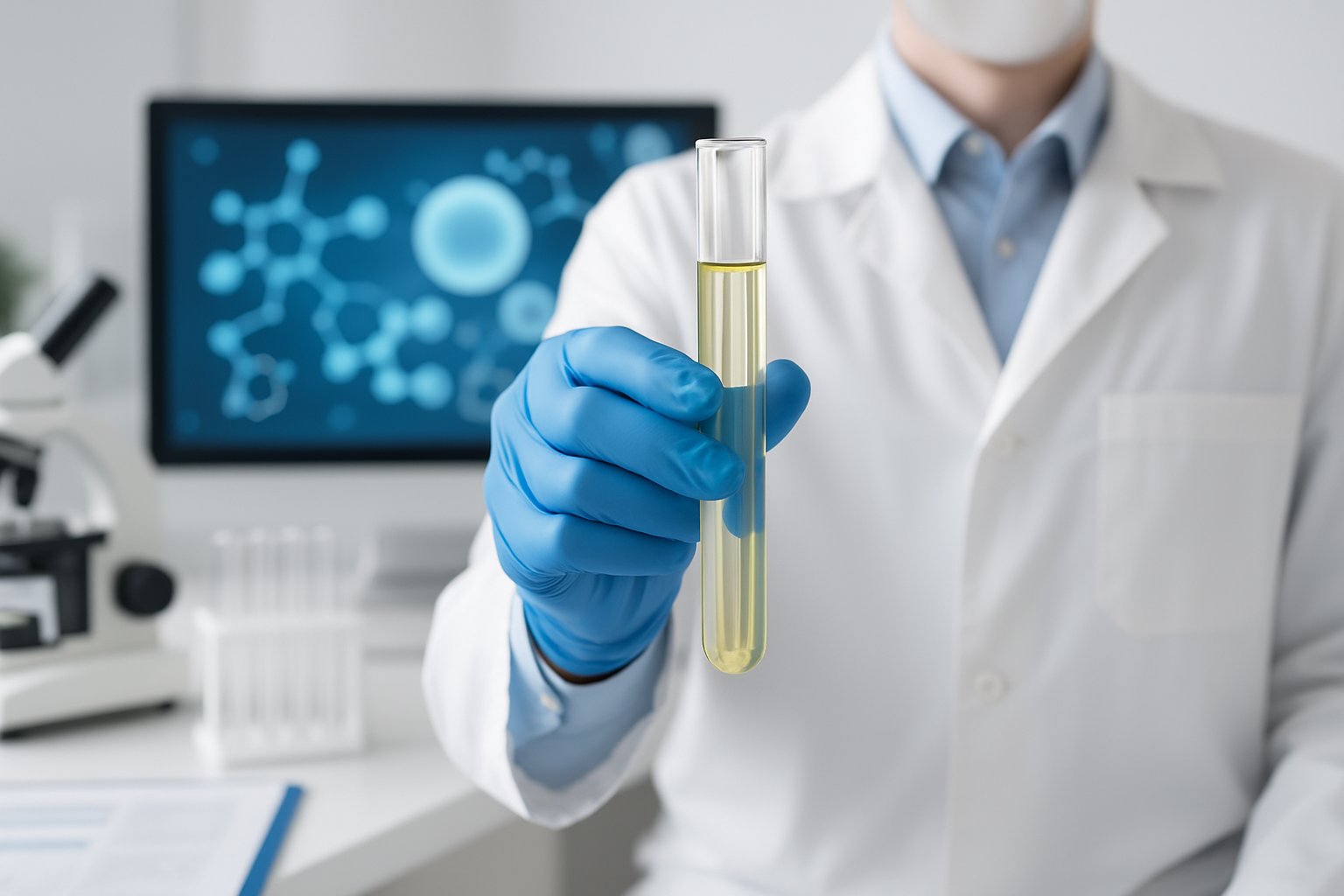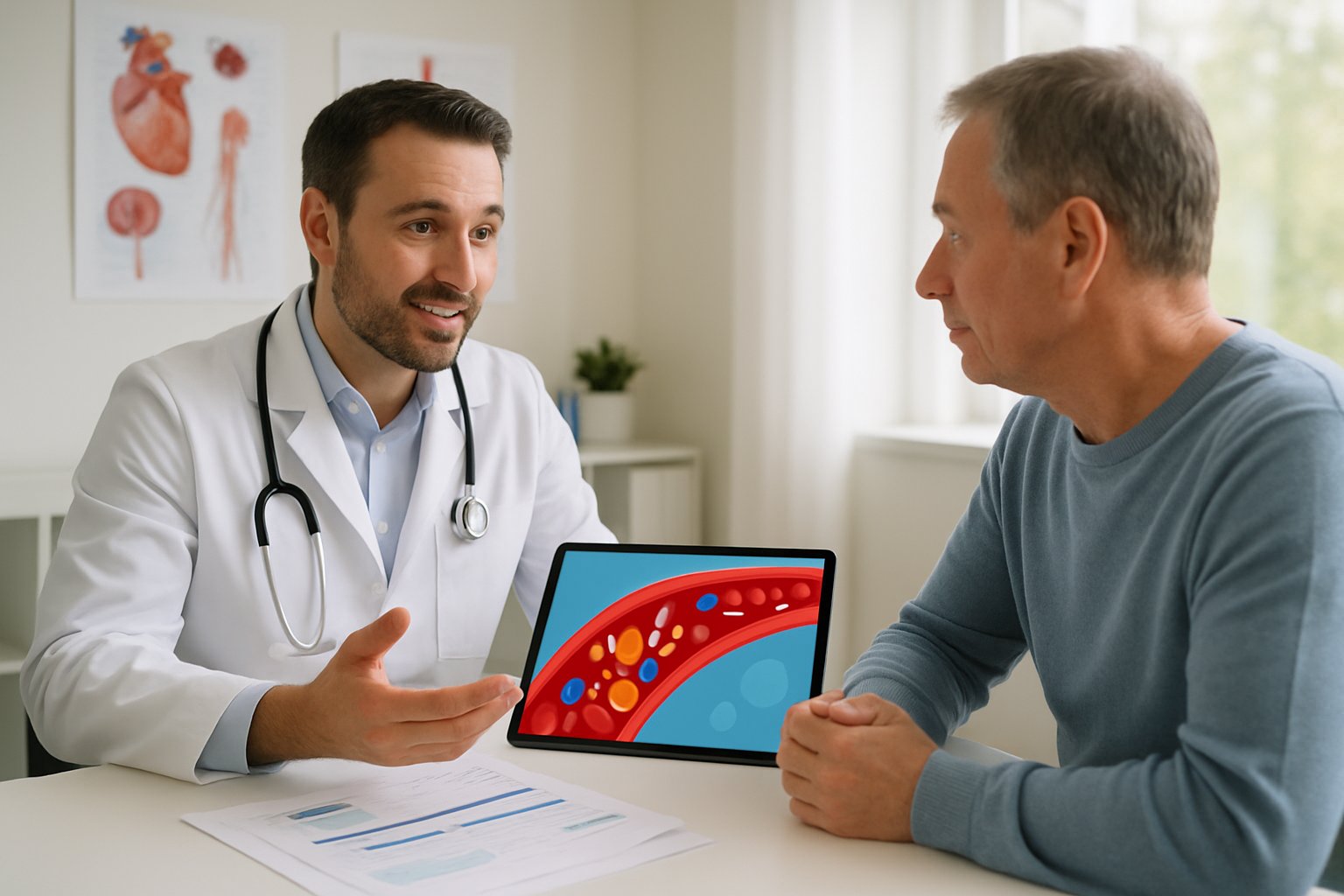Most people worry about high triglycerides, but low levels can also signal health problems that need attention. Low triglycerides usually indicate malnutrition, poor fat absorption, or underlying medical conditions like hyperthyroidism, though they can sometimes be a sign of good health in people without symptoms.

Low triglyceride levels under 10 mg/dl[1] are considered extremely low and may point to serious health issues. While low levels are often protective in healthy people[2], they become concerning when they drop too far below normal ranges.
Understanding what causes low triglycerides helps people know when to seek medical care. The underlying cause determines whether low levels are beneficial or a warning sign of a health condition that requires treatment.
Key Takeaways
- Low triglycerides can indicate malnutrition, malabsorption disorders, or medical conditions like hyperthyroidism
- Extremely low levels under 10 mg/dl may signal serious health problems requiring medical attention
- People should consult a doctor if they have symptoms alongside low triglyceride readings
What Are Triglycerides And Why Do They Matter?

Triglycerides are the most common type of fat in the human body and play essential roles in energy storage and metabolism. These lipids work alongside cholesterol and other blood fats as part of a complex system that affects cardiovascular health.
Role Of Triglycerides In The Body
Triglycerides are a very common kind of fat in your body[3] that serve multiple important functions. The body uses triglycerides primarily for energy storage and fuel.
When a person eats food, the body converts excess calories into triglycerides. Your liver also makes them, and when you eat extra calories — especially carbohydrates — your liver increases the production of triglycerides[4].
The body stores these triglycerides in fat cells for later use. When energy is needed, the body releases them as fatty acids. These fatty acids fuel body movement, create heat, and provide energy for essential body processes.
Normal triglyceride functions include:
- Energy storage for times when food is not available
- Insulation to help regulate body temperature
- Protection for vital organs
- Building blocks for cell membranes
Types Of Lipids And Lipoproteins
Lipids include several different types of fats that travel through the bloodstream. Cholesterol travels to your cells via special carriers called lipoproteins[4].
Major types of lipoproteins include:
| Lipoprotein Type | Function | Health Impact |
|---|---|---|
| LDL (Low-density) | Moves cholesterol from liver to body tissues | Called “bad” cholesterol – can form artery deposits |
| HDL (High-density) | Carries cholesterol back to liver for removal | Called “good” cholesterol – helps remove excess cholesterol |
| VLDL (Very low-density) | Carries triglycerides and some cholesterol | High levels linked to artery hardening |
Low-density lipoproteins (LDL) move cholesterol from the liver to other areas of the body, while high-density lipoproteins (HDL) carry cholesterol from body tissues back to the liver where it can be removed[4].
Difference Between Triglycerides And Cholesterol
Triglycerides and cholesterol are both lipids, but they have different structures and functions in the body. Understanding these differences helps explain why doctors measure both in blood tests.
Key differences include:
Triglycerides:
- Made of three fatty acid chains attached to glycerol
- Primary function is energy storage
- Levels change quickly based on recent meals
- Normal level is less than 150 mg/dL
Cholesterol:
- Has a ring-like chemical structure
- Used to make hormones and cell membranes
- Levels remain more stable throughout the day
- Measured as total cholesterol, HDL cholesterol, and LDL cholesterol
The total cholesterol reading in a lipid profile test measures the blood cholesterol in all the lipoproteins combined[4]. This test also measures triglycerides separately.
Both triglycerides and cholesterol levels affect heart disease risk. However, they impact cardiovascular health through different mechanisms and require different treatment approaches.
How Are Triglyceride Levels Measured?
Doctors measure triglycerides through a simple blood test that requires fasting beforehand. The test shows exact triglyceride numbers and compares them to normal ranges to identify low levels.
Understanding The Lipid Panel Test
Triglyceride testing[5] happens as part of a lipid panel test. This blood test measures several types of fats in the blood at once.
The lipid panel includes four main measurements:
- Total cholesterol
- LDL (bad) cholesterol
- HDL (good) cholesterol
- Triglycerides
Patients must fast for 8-12 hours before the test. Fasting is required for accurate triglyceride measurement[6] because triglyceride levels spike after eating.
During the test, a healthcare worker draws blood from a vein in the arm. The process takes just a few minutes. Lab technicians then analyze the blood sample to determine exact triglyceride levels.
Results are typically available within 1-2 days. The test measures triglycerides in milligrams per deciliter (mg/dL) of blood.
Normal Vs. Low Triglyceride Ranges
Standard triglyceride ranges[6] help doctors identify when levels are too low. Understanding these numbers helps patients know where their results fall.
Standard triglyceride ranges:
- Normal: Less than 150 mg/dL
- Borderline high: 150-199 mg/dL
- High: 200-499 mg/dL
- Very high: 500 mg/dL or above
Very low triglycerides are below 50 mg/dL[6]. This level is much less common than high triglycerides.
Some doctors prefer even lower normal ranges. Many experts suggest keeping triglycerides below 100 mg/dL for the best health outcomes.
Low triglyceride levels don’t always mean problems. Many healthy people have triglycerides between 50-100 mg/dL without any health issues.
Factors Affecting Triglyceride Test Results
Several factors can change triglyceride test results and affect accuracy. Patients should know about these factors before testing.
Factors that raise triglyceride readings:
- Eating within 12 hours of the test
- Drinking alcohol recently
- Taking certain medications
- Recent illness or stress
Factors that lower triglyceride readings:
- Extended fasting beyond 12 hours
- Recent intense exercise
- Some medications
- Certain health conditions
Timing matters for accurate results. The best time for testing is in the morning after fasting overnight. Patients should drink only water during the fasting period.
Medications can affect results significantly. Blood thinners, birth control pills, and steroids may change triglyceride levels. Patients should tell their doctor about all medications before testing.
Recent lifestyle changes also impact results. A person who just started a new diet or exercise program may see different numbers than usual.
Causes Of Low Triglycerides
Several medical conditions and factors can cause triglyceride levels to drop below normal ranges. Low triglycerides due to malnutrition can cause symptoms like lethargy, feeling cold, dry skin, brittle or sparse hair, muscle wasting, diarrhea, and weight loss[7].
Malnutrition And Nutritional Deficiencies
Malnutrition occurs when the body doesn’t get enough nutrients to function properly. This can happen from eating too little food or eating foods that lack important nutrients.
People with cancer often develop malnutrition because treatments like chemotherapy reduce appetite. Depression and memory loss also lead to poor eating habits that cause nutritional deficiencies.
When the body doesn’t get enough calories from food, it uses stored fat for energy. This process depletes fat stores and lowers triglyceride levels in the blood.
Severe weight loss from any cause can trigger this response. The body breaks down its own fat tissue to meet energy needs.
Very low-fat diets can also cause low triglycerides. While reducing dietary fat helps some people, the body still needs some fat to make triglycerides and absorb vitamins.
Malabsorption Disorders
Malabsorption disorders prevent the intestines from properly absorbing nutrients from food. Even when people eat enough, their bodies can’t use the nutrients effectively.
Celiac disease damages the small intestine when people eat gluten. This damage makes it hard to absorb fats and other nutrients.
Crohn’s disease causes inflammation in the digestive tract. The inflammation interferes with normal absorption of fats and calories.
Malabsorption syndrome[7] affects how the body processes dietary fats. When fat absorption fails, triglyceride production drops significantly.
Other conditions that cause malabsorption include:
- Pancreatic disorders
- Inflammatory bowel disease
- Chronic diarrhea
- Intestinal infections
Hyperthyroidism
Hyperthyroidism happens when the thyroid gland makes too much thyroid hormone. This speeds up the body’s metabolism dramatically.
Hyperthyroidism refers to an overactive thyroid that overproduces hormones, leading to sudden weight loss, increase in appetite, sweating, menstrual changes, fatigue, and sleep problems[7].
The faster metabolism burns through fat stores quickly. Triglycerides get used up faster than the body can make new ones.
People with hyperthyroidism often lose weight rapidly even when eating more food. Their bodies burn calories and fat at an unusually high rate.
Common symptoms include:
- Rapid heartbeat
- Sweating
- Anxiety
- Tremors
- Difficulty sleeping
Blood tests can measure thyroid hormone levels to confirm the diagnosis.
Genetic Conditions
Some people inherit genetic conditions that affect how their bodies make or process triglycerides.
Hypobetalipoproteinemia is a rare genetic disorder. People with this condition can’t make normal amounts of certain proteins needed to transport fats in the blood.
Abetalipoproteinemia is even rarer and more severe. The body can’t make the proteins needed to absorb and transport dietary fats at all.
These genetic conditions cause very low triglyceride levels from birth. They also affect the absorption of fat-soluble vitamins A, D, E, and K.
People with these disorders need special diets and vitamin supplements. Without treatment, they can develop serious nutritional deficiencies and health problems.
Family history often reveals other relatives with similar fat metabolism problems. Genetic testing can confirm these diagnoses.
Lifestyle And Medication Factors

Several lifestyle choices and medical treatments can cause triglyceride levels to drop below normal ranges. Diet changes, weight management, exercise routines, and certain medications all play important roles in triglyceride reduction.
Effect Of Dietary Changes And Low-Fat Diets
Low fat diets can significantly reduce triglyceride levels in the blood. When people cut back on dietary fats, their bodies produce fewer triglycerides naturally.
Extreme low-fat approaches may cause triglycerides to drop too low. Diets with less than 10% of calories from fat often lead to this problem.
People who avoid all fats miss out on healthy fats their bodies need. The body requires some fat to make important hormones and absorb vitamins.
Key dietary factors that lower triglycerides:
- Very low calorie diets
- Elimination of oils and butter
- Avoiding nuts and seeds
- Cutting out fatty fish
Some individuals replace fats with too many carbohydrates. This can cause other health problems even when triglycerides stay low.
Impact Of Weight Loss And Exercise
Rapid weight loss often causes triglyceride levels to fall quickly. People who lose more than 2 pounds per week may see their triglycerides drop below normal.
Exercise effects on triglycerides:
- Intense cardio burns triglycerides for energy
- Long workout sessions deplete stored fats
- Marathon training can cause very low levels
- Daily exercise without adequate fat intake
Weight loss of 10% or more in a short time period stresses the body’s fat storage system. The liver may not produce enough triglycerides to maintain normal levels.
Athletes and very active people often have naturally low triglycerides. Their bodies use fats so efficiently that blood levels stay minimal.
Medications That Lower Triglycerides
Several prescription drugs can cause triglycerides to fall too low when used incorrectly or in high doses.
Cholesterol-lowering drugs like statins sometimes reduce triglycerides more than expected. Doctors must monitor blood levels regularly during treatment.
Fibrates are powerful triglyceride reduction medications. These drugs can drop levels by 50% or more in some patients.
Common medications that affect triglycerides:
- Atorvastatin and other statins
- Fenofibrate and gemfibrozil
- High-dose omega-3 fatty acids
- Niacin supplements
Omega-3 fatty acids in prescription doses lower triglycerides effectively. Taking too much can cause levels to become dangerously low.
Some people take multiple triglyceride-lowering supplements together. This combination approach often leads to excessive reduction without medical supervision.
Health Implications Of Low Triglyceride Levels

Low triglyceride levels can signal underlying health problems and create new complications. These levels may affect heart health and the body’s ability to absorb important vitamins.
Potential Risks And Complications
Extremely low triglyceride levels[1] under 10 mg/dl can indicate serious medical conditions. These dangerously low levels often point to malnutrition or metabolic disorders.
Hyperthyroidism commonly causes low triglycerides. The overactive thyroid burns through fats too quickly. This condition affects metabolic health and requires medical treatment.
Malabsorption syndrome prevents the body from processing fats properly. Common causes include:
- Pancreatitis
- Liver disease
- Inflammatory bowel disease
- Celiac disease
People with these conditions cannot maintain normal triglyceride levels. The body struggles to absorb and use dietary fats.
Severe malnutrition also drops triglyceride levels dangerously low. Cancer, tuberculosis, and chronic infections can cause this problem. The body lacks the nutrients needed to produce triglycerides.
Low levels may signal insulin resistance in some cases. This affects how the body processes sugars and fats. Brain function can suffer when triglycerides drop too low, as the brain needs fats to work properly.
Relation To Cardiovascular Health
Low triglycerides do not directly cause heart disease or stroke. However, the conditions that create low levels can harm cardiovascular health.
Malnutrition weakens the heart muscle over time. The heart cannot pump blood effectively without proper nutrition. This increases the risk of heart failure and other complications.
Hyperthyroidism puts extra stress on the cardiovascular system. The heart beats faster and works harder than normal. This can lead to irregular heartbeats and high blood pressure.
Some research suggests very low triglycerides may not protect against atherosclerotic cardiovascular disease as much as moderate levels. The relationship between low triglycerides and heart health remains complex.
Balanced triglyceride levels support better cardiovascular outcomes than extremely low or high levels. The body needs some triglycerides for normal heart function and energy storage.
Effect On Fat-Soluble Vitamin Absorption
Low triglycerides often signal problems with fat absorption. This directly affects how the body processes vitamins A, D, E, and K.
Fat-soluble vitamins need dietary fats to enter the bloodstream. When triglycerides stay too low, vitamin deficiencies develop quickly. These vitamins support immune function, bone health, and blood clotting.
Vitamin A deficiency causes night blindness and immune problems. Vitamin D deficiency leads to weak bones and muscle pain. Vitamin E deficiency affects nerve function and muscle strength.
Vitamin K deficiency prevents proper blood clotting. Even small cuts can bleed excessively. This vitamin also supports bone health and heart function.
People with malabsorption conditions[1] need vitamin supplements and medical monitoring. A balanced diet alone cannot fix these deficiencies when the body cannot absorb fats properly.
Regular blood tests help track vitamin levels in people with consistently low triglycerides. Early treatment prevents serious complications from vitamin deficiencies.
When To Seek Medical Advice For Low Triglycerides
Low triglycerides usually don’t cause obvious symptoms, making regular testing important for detection. Medical attention becomes necessary when levels drop below 35 mg/dL or when symptoms suggest underlying health problems.
Recognizing Symptoms And When To Investigate
Most people with low triglycerides feel completely normal. The condition rarely causes direct symptoms that patients notice.
However, very low levels below 35 mg/dL may signal other health issues. These underlying problems can cause their own symptoms.
Common signs that warrant investigation include:
- Unexplained weight loss
- Persistent fatigue
- Muscle weakness
- Poor appetite
- Digestive problems
People should seek medical advice if they experience these symptoms along with known low triglyceride levels. Family history of metabolic disorders also increases the need for monitoring.
Routine blood tests often reveal low triglycerides before symptoms appear. Annual lipid panels help catch changes early.
Diagnostic And Monitoring Strategies
Doctors diagnose low triglycerides through standard lipid panel blood tests. These tests require fasting for 9-12 hours before the blood draw.
Normal triglyceride levels range from 50-150 mg/dL. Levels below 50 mg/dL are considered low.
Key diagnostic steps include:
- Complete metabolic panel
- Thyroid function tests
- Liver function assessment
- Nutritional status evaluation
Doctors may order additional tests to find underlying causes. These might include genetic testing for rare metabolic disorders.
Regular monitoring depends on the severity and cause. Patients with very low levels may need testing every 3-6 months. Those with mild reductions might only need annual checks.
Companies like Siphox Health offer convenient at-home testing options. Their heart and metabolic program includes triglyceride monitoring as part of comprehensive health tracking.
Long-Term Management Approaches
Treatment focuses on addressing underlying causes rather than raising triglyceride levels directly. Most cases don’t require specific intervention.
Nutritional counseling helps patients who have low levels due to poor diet. Adding healthy fats like olive oil and nuts can help normalize levels.
Management strategies include:
- Regular health monitoring
- Balanced nutrition planning
- Treatment of underlying conditions
- Medication adjustments when needed
Patients taking certain medications may need dose changes. Doctors work with patients to balance treatment benefits against triglyceride effects.
Follow-up appointments typically occur every 6-12 months. More frequent visits may be needed if triglyceride levels continue dropping or symptoms develop.
Long-term outlook is generally good for most patients. With proper monitoring and management, low triglycerides rarely cause serious health problems.
Frequently Asked Questions
Low triglyceride levels can signal underlying health problems and nutritional deficiencies. Most people wonder about symptoms, health risks, and when levels become dangerous.
What are the symptoms of having low triglyceride levels?
Low triglyceride levels often do not cause obvious symptoms on their own. Instead, people may experience symptoms related to the underlying condition causing the low levels.
Symptoms might include unexplained weight loss, fatigue, or digestive problems. These signs usually point to conditions like malnutrition or malabsorption disorders.
Some people may notice signs of vitamin deficiencies. Fat-soluble vitamins A, D, E, and K may not absorb properly when triglycerides are extremely low.
What health risks are associated with low triglycerides?
Low triglyceride levels can point to dangerous conditions[1] that need medical attention. The biggest risks come from the underlying causes rather than the low triglycerides themselves.
Malnutrition poses serious health threats. The body cannot function properly without essential nutrients and calories.
Malabsorption syndrome prevents the body from getting nutrients from food. This condition can lead to severe vitamin deficiencies and organ problems.
Hyperthyroidism speeds up metabolism too much. This condition can cause heart problems, bone loss, and muscle weakness if left untreated.
How might low triglycerides relate to the risk of developing cancer?
Cancer can cause extremely low triglyceride levels through multiple pathways. Tumors use large amounts of energy, which can deplete fat stores in the body.
Cancer treatments like chemotherapy may reduce appetite and cause nausea. These effects can lead to poor nutrition and weight loss.
Some cancers affect the digestive system directly. These tumors can prevent proper absorption of fats and nutrients from food.
Malabsorption syndrome, which includes cancer as a cause[1], often shows low triglycerides as an early sign.
What are the common causes of decreased triglyceride levels?
Very low-fat diets can cause extremely low triglyceride levels[1]. The body needs some dietary fat to maintain normal triglyceride levels.
Malnutrition from various causes leads to low triglycerides. Poor diet, eating disorders, and poverty can all result in inadequate nutrition.
Hyperthyroidism burns through calories and fat stores too quickly[1]. This overactive thyroid condition requires medical treatment.
Medical conditions like AIDS, liver disease, and pancreatitis interfere with fat absorption. These diseases prevent the body from processing fats normally.
What treatments exist for managing low triglyceride levels?
Treatment focuses on addressing the underlying cause rather than the low triglycerides directly. Doctors must identify and treat the root problem first.
Nutritional counseling helps people improve their diet. Adding healthy fats and ensuring adequate calories can raise triglyceride levels safely.
Medical conditions require specific treatments. Hyperthyroidism needs thyroid medication, while malabsorption disorders may need enzyme supplements.
Severe malnutrition might require supervised refeeding. Healthcare providers monitor patients carefully to avoid complications during recovery.
At what point is a triglyceride level considered dangerously low?
Normal triglyceride levels stay below 150 mg/dl[1]. Most healthy people have levels between 50-150 mg/dl.
Extremely low levels usually fall under 10 mg/dl and signal serious problems[1]. These numbers require immediate medical evaluation.
Levels between 10-35 mg/dl may also indicate health issues. Doctors typically investigate any reading below 35 mg/dl to rule out underlying conditions.
The exact danger point varies by individual health status. People with chronic diseases may have different target ranges than healthy individuals.
References
- Dangers of Low Triglyceride Levels. https://healthfully.com/dangers-of-low-triglyceride-levels.html Accessed October 28, 2025
- Why Are Your Triglycerides Low? Link to LDL & HDL Levels. https://labs.selfdecode.com/blog/low-triglycerides/ Accessed October 28, 2025
- Triglycerides: Levels & Normal Range. https://my.clevelandclinic.org/health/articles/11117-triglycerides Accessed October 28, 2025
- Content - Health Encyclopedia. https://www.urmc.rochester.edu/encyclopedia/content?contenttypeid=56&contentid=2967 Accessed October 28, 2025
- Content - Health Encyclopedia. https://www.urmc.rochester.edu/encyclopedia/content?contenttypeid=167&contentid=triglycerides Accessed October 28, 2025
- The quick guide to triglycerides, and why they matter | Levels. https://www.levels.com/blog/quick-guide-to-triglycerides Accessed October 28, 2025
- Low triglycerides: Common Causes and Symptoms. https://www.belmarrahealth.com/low-triglycerides-causes-symptoms/ Accessed October 28, 2025
